Char Siu Bao or char siu Pao ( 叉烧包 / Chinese bbq pork buns) is the most famous classic Cantonese dim sum. The soft and tender bun, the oozing soy-flavored thick gravy, and the meaty filling weave seamlessly into a perfect culinary masterpiece. This Chinese steamed bun takes center stage in all dim sum spread in every Chinese restaurant.
Images of eating Char Siu Bao (Chinese pork bun) with my parents at a bustling dim sum shop in Ipoh still flash vividly after over fifty years. This childhood memory is sweet and nostalgic. The excitement of waiting for the waitress to take out the steamingly hot Char Siu Pao from the dim sum trolly made me smile in reminiscence.

Note: This post may contain affiliate links. Please read my privacy policy for more info. I may receive commissions for purchases made through links in this post. As an Amazon Associate, I earn from qualifying purchases.
Note: I’ve created a summary of this lengthy article to help you navigate it more easily. Simply click on the section you’re interested in, and I’ll take you there right away! 😊
Part 1: What is Char Siu Bao?
Cha Siu Bao is a bun filled with barbecue pork (叉烧). In Chinese, barbecue pork is called Char Siu (or char siew), hence the name Cha Siu Bao. Traditionally, this pork bun is generally served for breakfast with Chinese tea, called yum cha (饮茶 / drinking tea ) by the people in Hong Kong. Nowadays, you can find Cha Siu Bao on many lunch menus in Chinese restaurants worldwide.
Dim sum is a delightfully Chinese delicacy usually served with tea. It literally translates to “touch the heart,” which means “take what your heart picks.”
The buns are steamed by high heat to let the dough expand rapidly and burst open at the top, partially revealing the meat filling. This steamed pork bun is best served hot straight from the steamer.
The buns of the classic recipe are filled with the stir-fried trimmings of roasted pork butt, which is slightly fatty but tender. You can use chicken meat instead of pork to suit people of all races and religions.
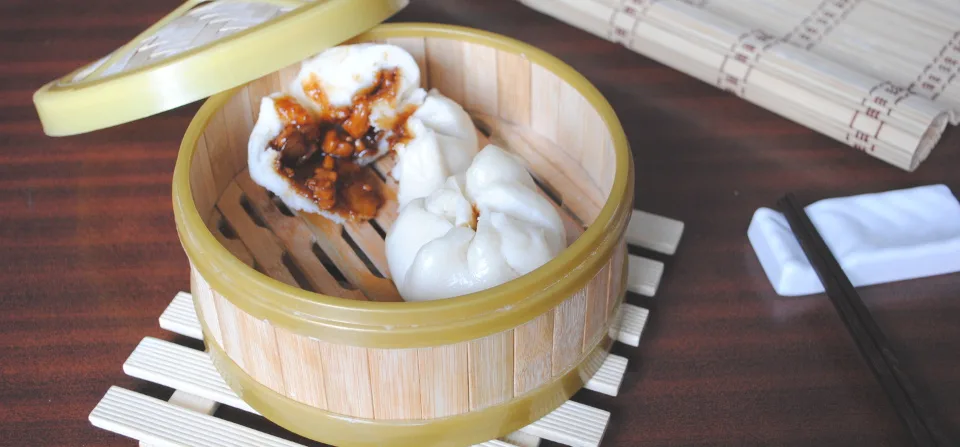
Part 2: How to make Char Siu Bao
Here are the detailed steps on how to make char siu bao. Please read this section before following the instructions in the recipe.
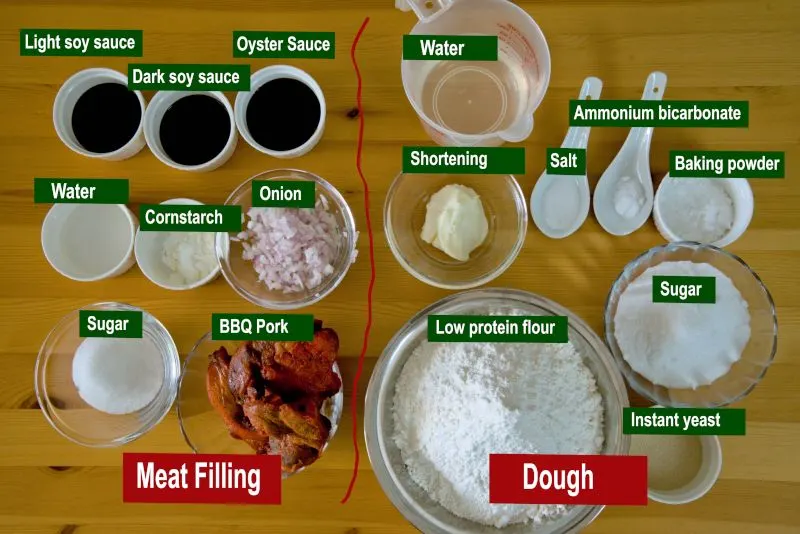
1. Prepare the meat filling for the bao
Here are the steps:
- Heat the oil in a pan or wok, and sauté the chopped onion for 1 to 2 minutes over medium heat until fragrant, soft and transparent.
- Add the diced meat and sauté until it is cooked.
- Add the remaining ingredients.- sugar, oyster sauce, light soy sauce, dark soy sauce, five-spice powder, cornstarch, and water.
- Stir and cook until the gravy thickens.
- Transfer to a plate and let it cool completely before using it as the filling.
Tips:
- It is important to cook the filling until the gravy is thick enough. If it is too diluted, it isn’t easy to seal the ingredients in the dough.
- You need to add a small amount of water so that it is juicy. The cornstarch will help to bind the ingredients together. I have water as part of the ingredients to cook the filling in the recipe, but you may notice that I did not add any when I demonstrated it in the video. As long as the consistency is like what I show in the video, it should be good to go.
- Traditionally, barbecue pork (char siu 叉烧) is used. You can use chicken breast meat as it is suitable for all races and religions. The flavor is very close to pork.
- No Hoisin sauce is used in the traditional Hong Kong style Char Siu Bao recipe.
- You can combine the cornflour with water to form a slurry before mixing it with the meat or add it directly to the pan. It does not matter.
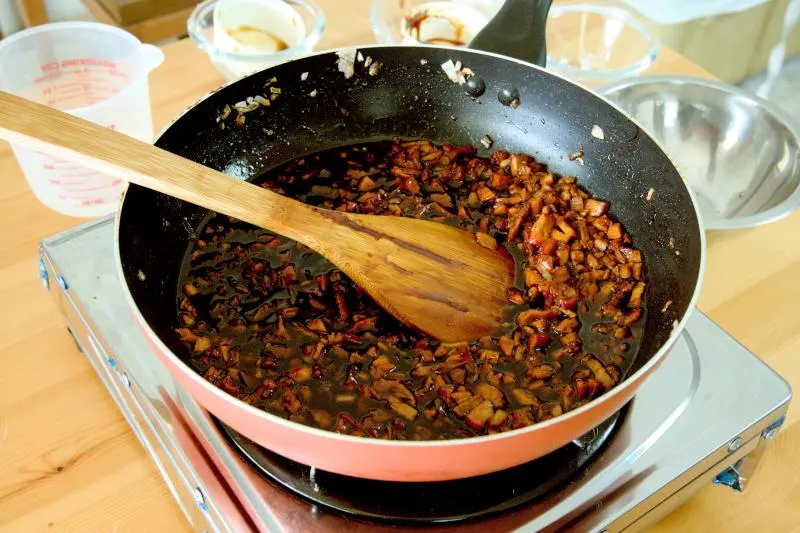
2. Make the dough for char siu bao
The method is pretty similar to making bread.
a. Prepare the starter
- Sprinkle the yeast in warm water. Wait for about five minutes or until it is completely dissolved. (If you use instant yeast, mix it with the flour and sugar without dissolving it.)
- Combine the flour and sugar with the yeast liquid.
- Mix well and cover for an hour.
b. Knead the dough
- Add the baking powder, ammonium bicarbonate, and flour to the starter mixture and knead for 8 minutes. Alternatively, use an electric mixer with a dough hook attachment.
- Add the shortening and salt and continue kneading until homogenous, nonstick, and shining.
- Cover the dough with a damp cloth and let it proof for 30 minutes or until the size doubles.
- Divide the dough into 50g equal pieces.
- Cover with a damp cloth and let the dough rest for 10 minutes before wrapping the filling.
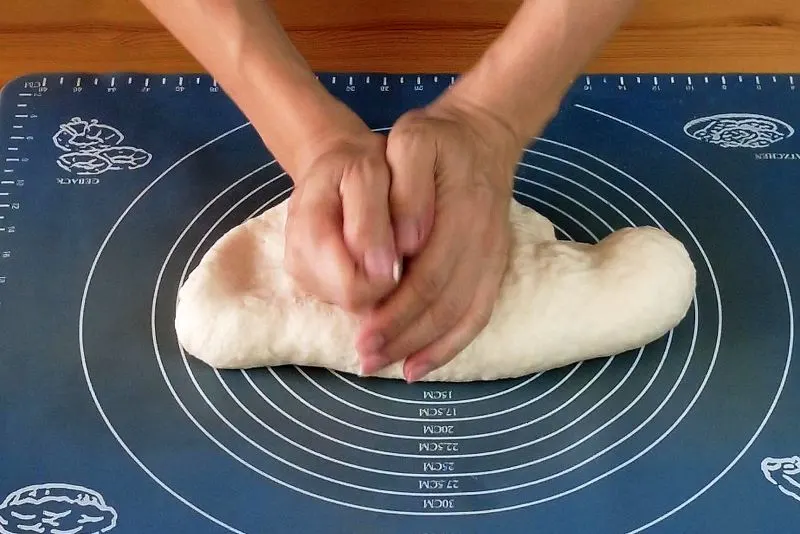
3. Wrap the filling
The next step is to encase the meat filling in the bao. Watching the embedded video is the best way to understand how to wrap the filing. The following is the summary:
- Roll out the dough with a rolling pin to a round shape, but leave the center slightly thicker, as this is the bottom part of the Pao.
- Wrap and pleat the dough to seal the filling.
- You can leave the bun at room temperature for twenty minutes before steaming. You do not need to wait until it doubles in size, like making bread. The baking powder + yeast + ammonium bicarbonate will raise the buns properly.
Note: It is not necessary to seal the Pao dough tightly. Just folding and slightly squeezing with your fingers is sufficient. This differs from shaping the pie crust, where the line you formed will stay even after baking. Most of the folding lines will disappear after steaming due to the strong leavening action of baking powder and yeast. It is (traditionally) acceptable if the dough is ‘erupted’ due to the rapid expansion of volume during steaming and review part of the filling.
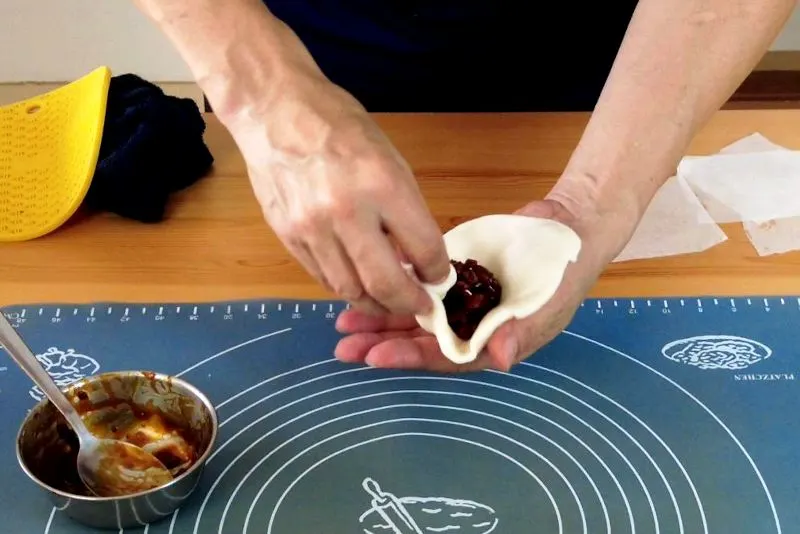
4. Steam the Char Siu Pao
- Place each Pao seal side on a small oiled baking paper. Let the Pao rest for 15 minutes before steaming.
- Place the Pao in a steamer tray (or the traditional bamboo steamer). Make sure the water is boiled rapidly.
- Steam the Pao on high heat for eight minutes with plenty of water and cover at all times during the entire steaming process.
Note: The bigger the paos, the longer you need to steam them. There will be a starchy taste for paos that are not fully cooked. It is harmless to steam a little longer than suggested.
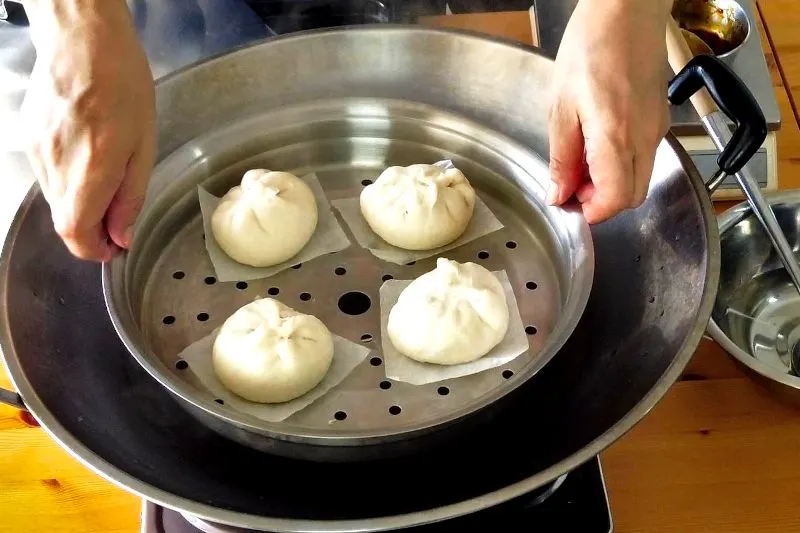
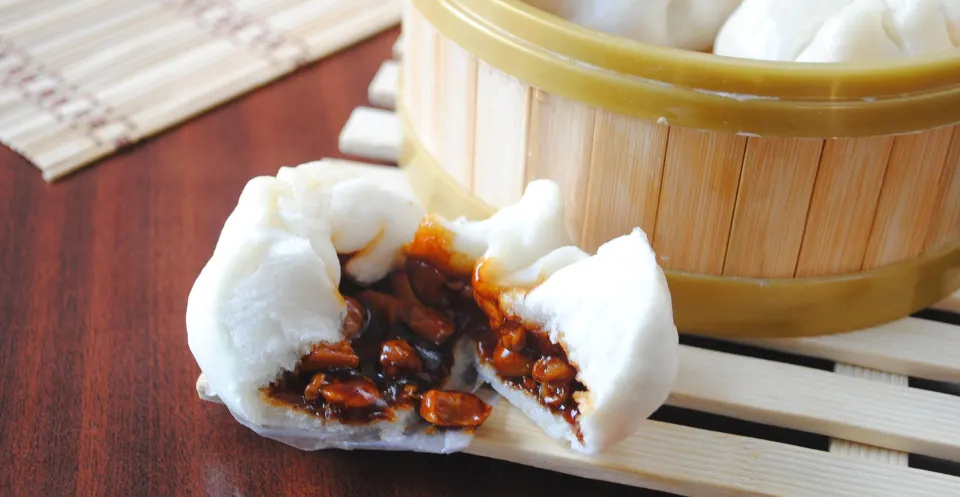
Part 3: My proven Char Siu Bao recipe with the juicy filling
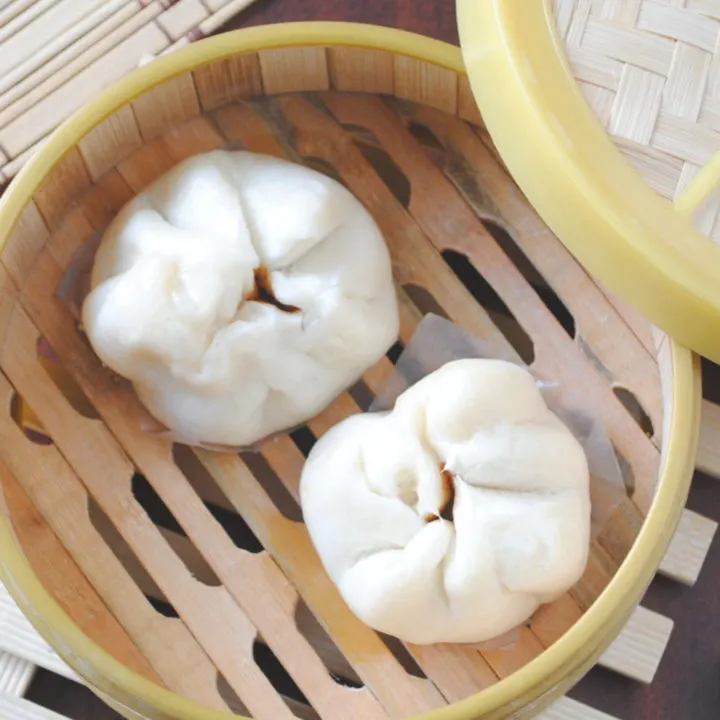
Char Siu Bao Recipe
Char Siu Bao is the most popular item in the Cantonese dim sum repertoire.
Ingredients
Dough starter
- 200 g (2.2 cups) of pao flour
- 10 g (3.2 tsp) Active dry yeast
- 145 g (1.1 cups) icing sugar
- 285 ml (1.2 cups) of lukewarm water
Other ingredients of the dough:
- 10 g (2.5 tsp) baking powder
- 400 g (4.4 cups) of pao flour
- 1/4 teaspoon white vinegar, optional
- 1/4 teaspoon ammonium bicarbonate, optional
- 50 g (1/4 cup) shortening
- 2 g (1/2 tsp) of salt
Filling:
- 400 g (0.9 pounds) of diced chicken breast meat, or use 80% lean pork and 20% pork fat
- 4 tbsp of sugar
- 12 g (1 1/4 tbsp) corn starch
- 200 ml of water
- 70 g (4.5 tbsp) oyster sauce
- 25 g (1.5 tsp) light soy sauce
- 35 g (2.5tbsp) dark soy sauce
- 50 g (1/3 cup) of onion
- 1 teaspoon Chinese five-spice powder
- 3 tbsp of oil
Instructions
Fillings:
- Heat 3 tablespoons of oil in a pan or wok, sauté the onion for 1 to 2 minutes until soft and transparent. Add the diced chicken breast meat and sauté until the chicken is cooked.
- Add the remaining ingredients. Stir and cook until the gravy thickens.
- Transfer to a plate and let it cool.
Dough:
- Dissolve the dry yeast in water.
- Add 200g of pao flour and icing sugar. Mix well and cover for an hour.
- Add the ingredients under the title 'Other ingredients of the dough' into the starter mixture and knead for 8 to 10 minutes.
- Cover the dough with a piece of damp cloth and let it proves for 30 minutes, or until the size has doubled.
- Divide the dough into 50g portions. Let the dough rest for 10 minutes.
- Flatten the dough with a rolling pin to form a circle of 8-10 cm in diameter. Place 30g of filling in the middle, wrap and pleat the dough to seal. Place it on a 1.5 inches (4cm) square baking paper, sealed side up. Rest for 15 minutes before steaming.
- Place the Char Siu Pao in a steamer, leave about 2-3 cm gap in between each Char Siu Pao. Steam in a preheated steamer on high heat for 8 minutes.
- Remove the Char Siu Pao immediately from the steamer and cool them on a rack to prevent the bottom of the Char Siu Pao from becoming soggy.
Recommended Products
As an Amazon Associate and member of other affiliate programs, I earn from qualifying purchases.
Nutrition Information:
Yield: 12 Serving Size: 12 baosAmount Per Serving: Calories: 410Total Fat: 12gSaturated Fat: 3gTrans Fat: 0gUnsaturated Fat: 8gCholesterol: 38mgSodium: 643mgCarbohydrates: 57gFiber: 2gSugar: 16gProtein: 18g
This data was provided and calculated by Nutritionix on 6/1/2019
Note
This recipe was originally developed in 2016 and has been revised several times. The current version is a complete rewrite of the original with new information and images. We have recently remade the video, which is now available on our YouTube channel. You can watch the new video on our YouTube Channel.
Part 4: Important information about making Char Siu Bao
Here is a list of important information I suggest you read before making Char Siu Bao.
1. Why do some chefs prepare a starter?
The technique of making the dough is similar to that of making bread. The main difference is using multiple types of leavening agents to achieve a tender, bouncy, and bursting surface. Of course, it is steamed, not baked. The buns are cooked in less than ten minutes due to the intense heat generated by the steam in the enclosed steamer.
Some chefs prefer to prepare a starter just like for making bread, as in this recipe. In this case, part of the flour will be used to prepare the starter. The flour will ferment longer, which will result in a better flavor.
2. Is lye water necessary in the recipe?
Lye water ( 碱水 )- some recipes suggest adding lye water to the dough. Our recipe has no lye water. There is a problem if you add too much lye water, as it will leave a bitter taste on the Pao. I do not use lye water in this recipe.
3. How about including wheat starch in the recipe?
Wheat starch ( 澄面粉) can be added to the recipe in a smaller amount. Wheat starch can produce a very soft and bouncy texture since wheat starch has no protein. The pao made following this recipe is quite soft, and there is no need to add wheat starch.
4. How about adding vinegar to the recipe?
Vinegar is added for a purpose. Since wheat starch has no protein, and Pao or Hong Kong flour has a low protein content, the development of gluten that contributes to the strength and texture will be limited. The ideal pH for gluten development is 5-6. This will encourage gluten development and produce a more extensible (easier to stretch) dough. Vinegar helps maintain the dough’s pH so that it is not too alkaline due to the use of baking powder and ammonium bicarbonate. This will produce Pao with good texture and yet is bouncy and soft.
However, I have tested my pao recipe and noticed that as long as the oil and flour are white, vinegar is unnecessary. Therefore, I omit vinegar in my recipe.
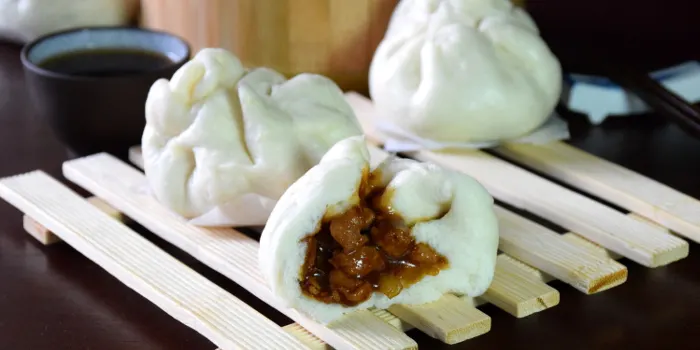
5. How do you make snowy white buns?
Some recipes suggest that vinegar can whiten the dough. However, we have tried to make Pao with and without vinegar, and the color of the Pao is identical.
The answer to the snowy white Char Siu Bao lies in the color of the flour and oil that you use. Hong Kong flour and Pao flour are bleached and will produce white Pao. If you use the standard cake or all-purpose flour, the color of the Char Siu Bao will be slightly yellowish.
The type of oil you use will affect the color of the Pao. The Pao will be slightly yellowish if you use vegetable or animal oil. We shortened the soy origin to produce a snowy white Pao. If you want a healthier alternative, use unbleached flour and vegetable oil instead of bleached flour and shortening, and the flavor will not be affected. But the Pao will not be as white as those from a professional dim sum shop.
6. Note on the leavening agent used for making Char Siu Bao
There are three leavening agents used in the recipe.
Baking powder (sodium bicarbonate) and yeast achieve a bouncy and soft texture. Both are quite common in baking, but you may be unfamiliar with ammonium bicarbonate.
Ammonium bicarbonate ( commonly known as 臭粉 In Chinese ) is a leavening agent nowadays seldom used. It is also hardly used in any Western baking products. It is used in the recipe to serve a special purpose- to produce the signature bursting surface of the Pao. The professional finishing of Char Siu Bao should be burst ( 开花 ) into three or four parts on the surface, much like the crevices on top of a hot cross bun. It is created by using ammonium bicarbonate instead of cutting lines on the surface of bread.
You can omit ammonium bicarbonate as it does not contribute to the flavor of the Char Siu Bao. The only difference is that the surface may not burst into parts, the ‘professional’ finishing of Char Siu Bao.
Note: Do not use an excessive amount of ammonium bicarbonate to avoid causing an unpleasant smell.
7. A special note on the different types of flour
Use the right type of flour to make Char Siu Bao. I have seen different types of flour to make pao suggested by chefs, and I would like to elaborate a little on this subject.
- The suitable flour for making Char Siu Bao is Pao flour or Hong Kong flour. The low protein percentage in these flour types will produce the optimum amount of gluten required for bouncy and soft buns. Both are bleached and can produce white buns normally seen in dim sum stores.
- The difference between Pao flour and Hong Kong flour is that yeast is added to some Pao flour, and it is not added to Hong Kong flour. You can add more dry yeast even if you use Pao flour, just in case the yeast is inactive. If you have difficulty getting Pao flour, you can use cake flour as it contains a similar percentage of gluten, but the color of the Pao will be slightly yellowish.
- Wheat flour contains protein and when it comes to contact with water, it develops gluten, which gives elasticity and strength to baked goods. Different baking items need different percentages of protein for optimum gluten development. Here is the summary:
Cake flour – 6-8% protein
Pastry flour, Pao flour, Hong Kong flour ( also known as Waterlily flour = 香港水仙面粉) 8-10% protein
Self-raising flour – 8-9% protein
All-purpose and plain flour – 10-12% protein
Bread flour – 12-14% protein
8. Storage: How to keep the Char Siu Pao for an extended period
You may want to make a large batch of Char Siu Bao and keep part of it. The best way is to steam only the number of pao you want and freeze the raw pao (with the cooked filling inside). This is the same way as keeping the raw bread dough in the bakery. Steamed buns can only last for a day or two, even if refrigerated.
- Place the freshly wrapped bao on a large baking tray. Put the bao tray in the freezer until the baos are hard enough. Please keep them in a plastic container in the freezer until you want to steam them.
- Arrange the frozen bao on a steamer tray and wait until it is at room temperature. You can now steam the bao just like the fresh one.
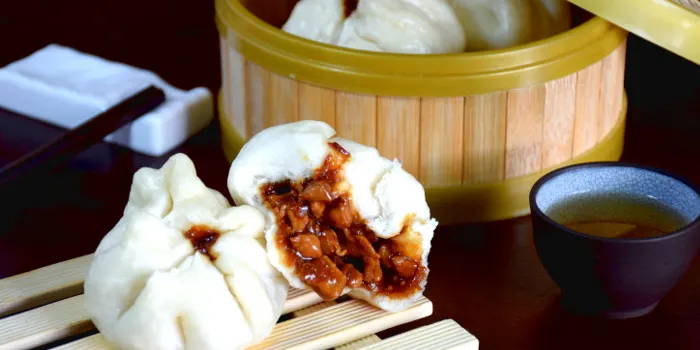
Part 5: Question and answers about making Char Siu Bao
Here is a list of frequently asked questions I have received since I posted this article in 2016. I hope you will find the answers useful.
1. Why do Pao flour and Hong Kong flour produce white buns?
It is because they are bleached. Freshly milled flour is bleached, and the natural color is yellowish. Bleaching will not only whiten the flour to make it more appealing, but it also further breaks down the gluten level and makes the flour softer.
2. Can I use only yeast or baking powder alone?
Some people may think using yeast and baking powder concurrently is unnecessary, but if you only use yeast alone and treat it like bread, the texture is not fluffy enough. You will notice that the texture of Bao is much fluffy compared to that of any bread or bun.
3. Can I use regular sugar instead of icing sugar?
Most chefs use icing sugar in the recipe. If you do not have icing sugar, use castor or granulated sugar. Coarse sugar is too rough and will not produce a smooth texture as desired.
4. Can I use chicken instead of pork?
The traditional recipe is called Char Siu Bao, and it is filled with barbecue pork. The pork should be cut into small pieces (do not mince it), which consist of a quarter of the fat. Small pieces of pork have a better mouthfeel and are preferred to minced pork. Some people prefer to use chicken instead of pork for this recipe. Chicken is especially popular among the Dim Sum restaurants in Malaysia, which they want to cater to the Muslims who do not eat pork.
You will notice that I use chicken in the recipe. Char Siu Bao is traditionally filled with pork in China. However, some restaurants fill it with chicken meat, which is equally delicious. If you like to use pork, just substitute the chicken with 80% lean pork and 20% pork fat. It will turn out fantastic.
Char Siu means barbecue meat, which can be any meat. There are stores in most Chinese communities that sell this type of barbecue meat as the bun filling. You can also make it yourself. If not, follow this recipe, and it will turn out just like using barbecue meat.
5. How about using butter instead of shortening?
Butter has a better flavor than shortening but is a little messy. This is entirely up to your description. I use shortening because the color is light and can produce near-white buns as you get in the dim sum restaurant. If you do not mind, the color is a little yellowish, so use butter that does not contain trans fat acid.
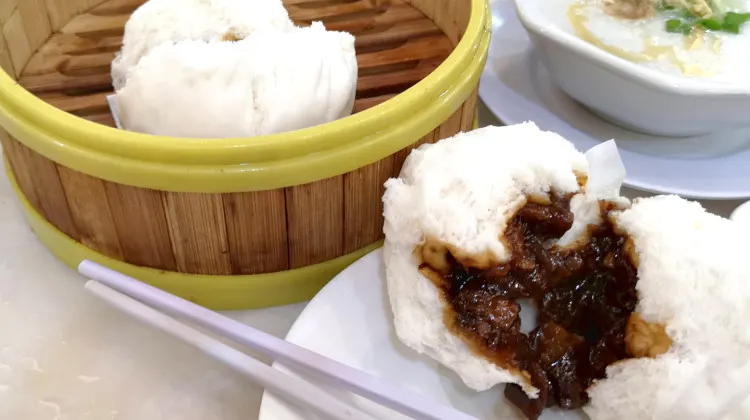
Part 6: More recipes for you
If you like this recipe, I suggest other popular Asian recipes for you to try. So here are my picks of some of the most popular recipes from where I live, Malaysia:
- Chinese-style chicken herbal soup is well-known for its health benefits. Besides that, it is incredibly delicious.
- Everyone loves the fragrance and taste of biryani rice. However, since I know it is time-consuming to prepare, I have added a section at the end of the article about a quick and easy method.
- If you like fried rice, you must not miss the Malay-style fried rice called nasi goreng kampung. Beware, it is spicy 🙂

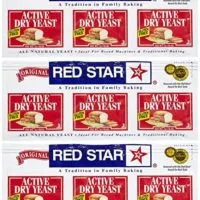
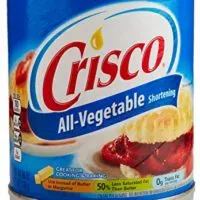
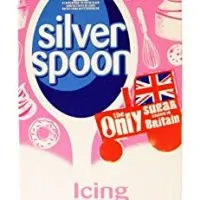
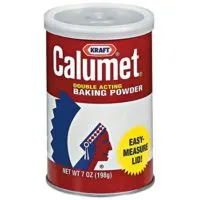
How to make Shumai 烧卖 - the most popular Cantonese Dim Sum recipe
Friday 25th of October 2024
[…] Char Siu Bao is another classic Cantonese dim sum. The recipe is on our sister food blog, Taste of Asian Food. […]
How to make Char Siu (Homemade Chinese barbeque pork)
Sunday 13th of October 2024
[…] Char Siu Bao is the most famous classic Cantonese dim sum. Find out how to make this Chinese steamed bun served in every Dim Sum restaurant. […]
Steph
Tuesday 12th of September 2023
In your detailed steps, you kneaded the baking powder, flour, and starter for 8 minutes before adding the shortening and salt and kneading again. In the recipe, you added all of the other ingredients and kneaded them all togehter. Is there a difference/benefit to doing it in 2 steps and is total kneading time still about 8-10minutes?
KP Kwan
Friday 15th of September 2023
There is no difference in practice in both ways.
JS
Tuesday 21st of December 2021
i used cake flour and followed your recipe. but my buns trurned out stained with brown/yellowish stain. :( you have any advice for me? thanks! texture and tastes was great btw. just the color annoys me.
KP Kwan
Wednesday 22nd of December 2021
If you don't mind the color, just be it. Those restaurants use bleached flour; that is why it is so white. If you are living where you can get Hong Kong Flour/Pau Flour/水仙面粉, those are flour that will produce a white bun. Also, some chefs use shortening instead of lard or butter, which is near whtie.
Graess
Saturday 23rd of October 2021
If I don't have any more lard how much oil should I use to replace shortening ?
KP Kwan
Saturday 23rd of October 2021
You can replace with an equal amount of lard with shortening.